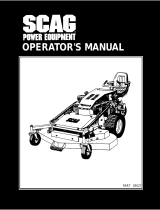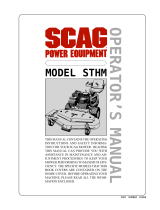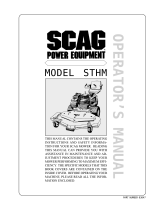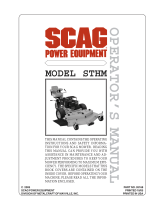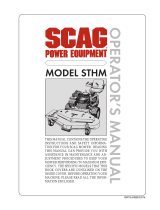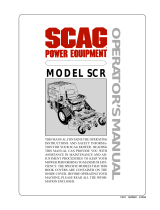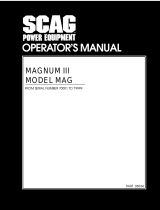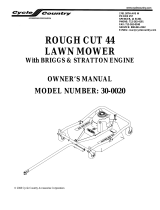Page is loading ...

MODEL STC
OPERATOR’S MANUAL
THIS MANUAL CONTAINS THE OPERATING
INSTRUCTIONS AND SAFETY INFORMA-
TION FOR YOUR SCAG MOWER. READING
THIS MANUAL CAN PROVIDE YOU WITH
ASSISTANCE IN MAINTENANCE AND AD-
JUSTMENT PROCEDURES TO KEEP YOUR
MOWER PERFORMING TO MAXIMUM EFFI-
CIENCY. THE SPECIFIC MODELS THAT THIS
BOOK COVERS ARE CONTAINED ON THE
INSIDE COVER. BEFORE OPERATING YOUR
MACHINE, PLEASE READ ALL THE INFOR-
MATION ENCLOSED.
PART NO. 03134
PRINTED 7/03
PRINTED IN USA
© 2003
SCAG POWER EQUIPMENT
DIVISION OF METALCRAFT OF MAYVILLE, INC.

FAILURE TO FOLLOW SAFE OPERATING PRACTICES
MAY RESULT IN SERIOUS INJURY.
* Keep all shields in place, especially the grass discharge chute.
* Before performing any maintenance or service, stop the machine and
remove the spark plug wire and ignition key.
* If a mechanism becomes clogged, stop the engine before cleaning.
* Keep hands, feet and clothing away from power-driven parts.
* Read this manual completely as well as other manuals that came
with your mower.
* Keep others off the tractor (only one person at a time)
REMEMBER - YOUR MOWER IS ONLY AS SAFE AS THE OPERATOR!
Hazard control and accident prevention are dependent upon the awareness,
concern, prudence, and proper training of the personnel involved in the
operation, transport, maintenance, and storage of the equipment.
This manual covers the operating instructions
and illustrated parts list for:
STC48A-19KA with a serial number of 9250001 to 9259999
STC48A-20CV with a serial number of 9260001 to 9269999
STC48A-21KA with a serial number of 9280001 to 9289999
STC52A-23KA with a serial number of 9290001 to 9299999
STC52A-24HN with a serial number of 9300001 to 9309999
SMTC-48A with a serial number of 9320001 to 9329999
SMTC-52A with a serial number of 9330001 to 9339999
Always use the entire serial number listed on the serial number
tag when referring to this product.
WARNING:

I
TABLE OF CONTENTS
SUBJECT PAGE
Section 1 - General Information
1.1 Introduction .............................................................................................................................1
1.2 Directional Reference.............................................................................................................1
1.3 Servicing the Engine and Drive Train Components ................................................................1
1.3 Symbols ............................................................................................................................... 2-3
Section 2 - Safety Information
2.1 Introduction .............................................................................................................................4
2.2 Signal Words ...........................................................................................................................4
2.3 Before Operation Considerations ...........................................................................................4
2.4 Operation Considerations........................................................................................................5
2.5 Roll Over Protection System (Optional) .................................................................................6
2.6 Maintenance Considerations ...................................................................................................7
2.7 Safety and Instructional Decals ..............................................................................................8
Section 3 - Specifications ..................................................................................................... 9-10
Section 4 - Operating Instructions
4.1 Controls and Instrument Identification ..................................................................................11
4.2 Safety Interlock System........................................................................................................12
4.3 Initial Run-In Procedures......................................................................................................13
4.4 Starting the Engine................................................................................................................13
4.5 Ground Travel and Steering ..................................................................................................13
4.6 Engaging the Deck Drive .....................................................................................................14
4.7 Hillside Operation .................................................................................................................15
4-8 Parking the Mower ...............................................................................................................15
4.9 After Operation ....................................................................................................................15
4.10 Removing Clogged Material .................................................................................................15
4.11 Moving Mower with Engine Stopped ...................................................................................16
4.12 Recommendations for Mowing .............................................................................................16
4.13 Adjusting Cutting Height .......................................................................................................16
Section 5 - Troubleshooting Cutting Conditions.............................................................18-20
4.14 Towing ..................................................................................................................................17

II
TABLE OF CONTENTS (CONT'D)
SUBJECT PAGE
Section 6 - Adjustments
6.1 Parking Brake Adjustment ....................................................................................................21
6.2 Travel Adjustments ...............................................................................................................22
6.3 Throttle Control and Choke Adjustments ..............................................................................23
6.4 Belt Adjustment ....................................................................................................................23
6.5 Belt Alignment ......................................................................................................................23
6.6 Cutter Deck Adjustments .....................................................................................................24
Section 7 - Maintenance
7.1 Maintenance Chart ...............................................................................................................27
7.2 Lubrication Fitting Points ......................................................................................................28
7.3 Hydraulic System ..................................................................................................................30
7.4 Engine Oil .............................................................................................................................31
7.5 Engine Fuel System ..............................................................................................................31
7.6 Engine Air Cleaner................................................................................................................32
7.7 Battery ..................................................................................................................................32
7.8 Drive Belts ............................................................................................................................34
7.9 Cutter Blades ........................................................................................................................34
7.10 Tires ......................................................................................................................................35
7.11 Body, Deck and Upholstery ..................................................................................................35
Section 8 - Replacement Parts
STC48A, STC52A Cutter Deck ............................................................................................... 36-37
Cutter Deck Controls................................................................................................................ 38-39
Sheet Metal Components.......................................................................................................... 40-41
Drive System Components ....................................................................................................... 42-43
Engine and Attaching Parts - Kawasaki & Kohler .................................................................. 44-45
Engine and Attaching Parts - Honda ........................................................................................ 46-47
Steering Components ................................................................................................................ 48-49
Brake Components ................................................................................................................... 50-51
Fuel and Hydraulic System ....................................................................................................... 52-53
Electrical System (Kawasaki & Kohler).................................................................................. 54-55
Hydraulic Pump (BDP-10A) .................................................................................................... 56-57
Replacement Decals................................................................................................................. 58-59
Electrical Schematic (Kawasaki & Kohler) ...................................................................................60
Warranty Statement...........................................................................Following Illustrated Parts List

1
GENERAL INFORMATION
1.1 INTRODUCTION
Your mower was built to the highest standards in the
industry. However, the prolonged life and maximum
efficiency of your mower depends on you following the
operating, maintenance and adjustment instructions in this
manual.
If additional information or service is needed, contact your
Scag Power Equipment Dealer.
We encourage you to contact your dealer for repairs. All
Scag dealers are informed of the latest methods to service
this equipment and provide prompt and efficient service in
the field or at their service shop. They carry a full line of
Scag service parts.
USE OF OTHER THAN ORIGINAL SCAG
REPLACEMENT PARTS WILL VOID THE
WARRANTY.
When ordering parts, always give the model and serial
number of your tractor. The serial number plate is located
where shown in Figure 1-1.
For pictorial clarity, some illustrations and figures in this
manual may show shields, guards or plates open or removed.
Under no circumstances should your mower be operated
without these devices in place.
All information is based upon product information
available at the time of approval for printing. Scag
Power Equipment reserves the right to make changes
at any time without notice and without incurring any
obligation.
1.2 DIRECTION REFERENCE
The “Right” and “Left”, “Front” and “Rear” of the machine
are referenced from the operator’s right and left when
seated in the normal operating position and facing the
forward travel direction.
1.3 SERVICING THE ENGINE AND DRIVE
TRAIN COMPONENTS
The detail servicing and repair of the engine, hydraulic pumps
and gearboxes are not covered in this manual; only routine
maintenance and general service instructions are provided.
For service of these components during the limited warranty
period, it is important to contact your Scag dealer or find a
local authorized servicing agent of the component
manufacturer.
Any unauthorized work done on these
components during the warranty period may void your
warranty.
Section 1
Figure 1-1 Tractor Serial Number Plate Location
Model
Serial
SCAG
Power Equipment
STC 2001 SPL-1
SERIAL NUMBER
PLATE LOCATION

3
Slow
Fast
Cutting Element - Engage
Cutting Element - Basic symbol
Cutting Element - Disengage
Continuously Variable - Linear
Read Operator's Manual
Keep Bystanders Away
Pinch Point
481039S
SYMBOL DESCRIPTION SYMBOL DESCRIPTION
Hourmeter/Elapsed Operating Hours
Thown Object Hazard

4
SAFETY INFORMATION
2.1 INTRODUCTION
Your mower is only as safe as the operator. Carelessness
or operator error may result in serious bodily injury or death.
Hazard control and accident prevention are dependent upon
the awareness, concern, prudence, and proper training of
the personnel involved in the operation, transport,
maintenance and storage of the equipment.
Make sure
every operator is properly trained and thoroughly familiar
with all of the controls before operating the mower.
READ THIS OPERATOR’S MANUAL BEFORE
ATTEMPTING TO START YOUR MOWER.
A replacement manual is available from your authorized
Scag Service Dealer or by contacting Scag Power
Equipment, Service Department at P.O. Box 152, Mayville,
WI 53050 or contact us via the Internet at www.scag.com.
Use the Contact Form to make your request. Please indicate
the complete model and serial number of your Scag product
when requesting replacement manuals.
2.2 SIGNAL WORDS
This symbol means “Attention! Become Alert! Your
Safety is Involved!" The symbol is used with the
following signal words to attract your attention to safety
messages found on the mower decals and throughout this
manual. The message that follows the symbol contains
important information about safety. To avoid injury and
possible death, carefully read the message! Be sure to
fully understand the causes of possible injury or death.
Signal Word:
It is a distinctive word found on the mower safety decals
and throughout this manual that alerts the viewer to the
existence and relative degree of the hazard.
The signal word “WARNING” denotes that a hazard exists
on or near the machine that can result in injury or death if
proper precautions are not taken.
The signal word “DANGER” denotes that an extremely
hazardous situation exists on or near the machine that could
result in high probability of death or irreparable injury if
proper precautions are not taken.
CAUTION:
The signal word “CAUTION” is a reminder of safety
practices on or near the machine that could result in personal
injury if proper precautions are not taken.
Your safety and the safety of others depends significantly
upon your knowledge and understanding of all correct
operating practices and procedures of this machine.
2.3 BEFORE OPERATION
CONSIDERATIONS
1. NEVER allow children to operate this riding mower.
Do not allow adults to operate this machine without
proper instructions.
2. DO NOT mow when children and/or others are
present.
3. Clear the area to be mowed of objects that could be
picked up and thrown by the cutter blades.
4. DO NOT carry passengers.
WARNING:
Section 2

5
11. Keep flammable objects (cigarettes, matches, etc.),
open flames and sparks away from the fuel tank and
fuel container.
12. Equipment must comply with the latest requirements
per SAE J137 and/or ANSI/ASAE S279 when driven
on public roads.
-NOTE-
If the mower is driven on public roads, it must comply
with state and local ordinances as well as SAE J137
and/or ANSI / ASAE S279 requirements. Contact
your local authorities for regulations and
equipment requirements.
13. DO NOT operate without the side discharge chute
installed and in the down position.
14. Check the blade mounting bolts at frequent intervals
for proper tightness.
15. Make sure all hydraulic fluid connections are tight and
all hydraulic hoses and lines are in good condition before
starting the machine.
2.4 OPERATION CONSIDERATIONS
1. Know the function of all controls and how to stop
quickly.
2. Reduce speed and exercise extreme caution on slopes
and in sharp turns to prevent tipping or loss of control.
Be especially cautious when changing directions on
slopes.
DO NOT operate on steep slopes. To check a slope,
attempt to back up it (with the cutter deck down). If
the machine can back up the slope without the
wheels slipping, reduce speed and use extreme
caution. ALWAYS FOLLOW OSHA APPROVED
OPERATION.
2.3 BEFORE OPERATION
CONSIDERATIONS (CONT'D)
5. DO NOT wear loose fitting clothing that could get
tangled in moving parts. Do not operate the machine
wearing shorts; always wear adequate protective
clothing including long pants. Wearing safety glasses,
safety shoes and a helmet is advisable and is required
by some local ordinances and insurance regulations.
6. Operator hearing protection is recommended,
particularly for continuous operation of the mower.
Wear suitable hearing protection. Prolonged exposure
to loud noise can cause hearing impairment or loss.
7. Keep the machine and attachments in good operating
condition. Keep all shields and safety devices in place.
If a shield, safety device or decal is defective or
damaged, repair or replace it before operating the
machine.
This machine is equipped with an interlock system
intended to protect the operator and others from
injury. This is accomplished by preventing the
engine from starting unless the deck drive is
disengaged, the parking brake is on, the steering
control levers are in the neutral position and the
operator is in the seat. The system shuts off the
engine if the operator leaves the seat with the deck
drive engaged and/or the steering control levers not
in the neutral position and the parking brake not
engaged. Never operate equipment with the interlock
system disconnected or malfunctioning.
8. Be sure the interlock switches are functioning correctly.
9. Fuel is flammable; handle it with care. Fill the fuel
tank outdoors. Never fill it indoors. Use a funnel or
spout to prevent spillage. Clean up any spillage before
starting the engine.
10. DO NOT add fuel to a running or hot engine. Allow
the engine to cool for several minutes before adding
fuel.
Section 2
WARNING:
WARNING:

6
Section 2
2.4 OPERATION CONSIDERATIONS
(CONT'D)
3. To prevent tipping or loss of control, start and stop
smoothly, avoid unnecessary turns and travel at reduced
speed.
4. When using any attachment, never direct the discharge
of material toward bystanders or allow anyone near
the machine while in operation.
5. Before attempting to start the engine, with the operator
in the seat, disengage power to the cutter deck, place
the steering control levers in the neutral position and
engage the parking brake.
6. If the mower discharge ever plugs, shut off the engine,
remove the ignition key, and wait for all movement to
stop before removing the obstruction.
Do not use your hand to dislodge the clogged
discharge chute. Use a stick or other device to
remove clogged material.
7. Be alert for holes, rocks, roots and other hidden hazards
in the terrain. Keep away from any dropoff. Beware
of overhead obstructions (low limbs, etc.), underground
obstacles (sprinklers, pipes, tree roots, etc.). Cautiously
enter a new area. Be alert for hidden hazards.
8. Disengage power to cutter deck before backing up.
Do not mow in reverse unless absolutely necessary
and then only after observation of the entire area behind
the mower.
9. DO NOT turn sharply. Use care when backing up.
10. Disengage power to cutter deck before crossing roads,
walks or gravel drives.
11. Mow only in daylight or good artificial light.
12. Take all possible precautions when leaving the machine
unattended, such as disengaging the mower, lowering
the attachments, setting the parking brake, stopping the
engine, and removing the key.
13. Disengage power to the attachments when transporting
or when not in use.
14. The machine and attachments should be stopped and
inspected for damage after striking a foreign object,
and damage should be repaired before restarting and
operating the machine.
DO NOT touch the engine or the muffler while
the engine is running or immediately after
stopping. These areas may be hot enough to
cause a burn.
DO NOT run the engine inside a building or a
confined area without proper ventilation. Exhaust
fumes are hazardous and could cause death.
2.5 ROLL OVER PROTECTION SYSTEM
(OPTIONAL)
This mower has been designed for good traction and stability
under normal mowing conditions. However, caution must
be used when traveling on slopes, especially when the grass
is wet. Wet grass reduces traction and steering control.
An optional Roll Over Protection System is available for
this machine (see authorized dealer for details) and should
be installed if the machine is to be operated on slopes or
inclines to insure operator safety.
After initial installation by authorized dealer, any or all parts
of the Roll Over Protection System MUST NOT be
removed. Failure to adhere to this guideline could result in
injury or death.
ROP's Operating Instructions.
1. Securely fasten seat belt during operation of the
machine.
WARNING:
WARNING:
CAUTION:

7
2. Whenever possible, avoid operating the machine near
ditches, embankments and steep inclines.
3. Reduce speed when turning, operating on slopes, slick
or wet surfaces. Allow extra distance to stop.
4. Stay off of slopes too steep for safe operation. To check
a slope, attempt to back up it (with the cutter deck
down). If the machine cannot back up the slope without
the wheels slipping, do not operate the machine on this
slope.
5. Always travel up or down the slope whenever possible.
Never across the slope.
6. Operate the machine smoothly, no sudden turns, starts
or stops on a slope.
7. Never tow on slopes. The weight of the towed
equipment may cause loss of traction and loss of control.
8. DO NOT permit untrained personnel to operate the
machine.
2.6 MAINTENANCE CONSIDERATIONS
1. Never make adjustments to the machine with the
engine running unless specifically instructed to do so.
If the engine is running, keep hands, feet, and clothing
away from moving parts.
2. Remove the key from the ignition switch to prevent
accidental starting of the engine when servicing or
adjusting the machine.
3. Keep all nuts, bolts and screws tight, to ensure the
machine is in safe working condition. Check blade
mounting bolts frequently to be sure they are tight.
4. Do not change the engine governor settings or
overspeed the engine. See the engine operator's manual
for information on engine settings.
5. To reduce fire hazard, keep the engine free of grass,
leaves, excessive grease, oil and dirt.
Hydraulic fluid is under high pressure. Keep body
and hands away from pinholes or nozzles that eject
hydraulic fluid under high pressure. Hydraulic
fluid under high pressure may have sufficient force
to penetrate skin and cause serious injury. If
hydraulic fluid is injected into the skin, it must be
surgically removed within a few hours by a doctor
or gangrene may result. If you need service on
your hydraulic system, please see your authorized
Scag dealer.
CAUTION:

8
Section 2
2.7 SAFETY AND INSTRUCTIONAL DECALS
482285
481039
481568
482290
482286
482576
482709
STC Safety Decals
482834

9
Section 3
SPECIFICATIONS
3.1 ENGINE
General Type .............................................................................. Heavy Duty Industrial/Commercial Gasoline
Brand ......................................................................................... Kawasaki, Kohler, Honda
Horsepower................................................................................ 19 HP (Spec.#FH601V) (Scag Model STC48A-19KA)
20 HP (Spec.#CV20S) (Scag Model STC48A-20CV)
21 HP (Spec.#FH641V) (Scag Model STC48A-21KA, STC52A-21KA)
23 HP (Spec.#FH680V) (Scag Model STC52A-23KA)
24 HP (Spec. #GXV670TAF2) (Scag Model STC52A-24HN)
Type 4 Cycle Gasoline, Twin Cylinder, Horizontal Shaft
Cylinders.................................................................................... 2 with Cast Iron Sleeves
Governor .................................................................................... Mechanical Type with Variable Speed Control Set At 3600 RPM
Idle Speed .................................................................................. 1550 RPM - Kawasaki
1900 RPM - Kohler
1350 RPM - Honda
Kawasaki Fuel Pump Group ....................................................... Mechanical Fuel Pump with In-Line Fuel Filter, Fixed Jet Downdraft
Carburetor.
Fuel ............................................................................................ Non-Leaded Gasoline with a Minimum Octane Rating of 87
Oil Pump Group .......................................................................... Positive Displacement Gerotor™ Oil Pump
Starter......................................................................................... Electric Starting with Solenoid Shift Starter
Belts: .......................................................................................... Kevlar cord. Self-adjusting, Self-tightening
Pump Drive Belt ......................................................................... Scag Part Number - 482716
3.2 ELECTRICAL
Battery ....................................................................................... 12 Volt
Charging System ........................................................................ Alternator
Charging Output ........................................................................ 12 Volt, 13 Amp - Kawasaki
12 Volt, 15 Amp - Kohler
System Polarity .......................................................................... Negative Ground
Starter......................................................................................... 12 Volt Electric Ring Gear Type, Key and Solenoid Operated Interlock
Switches..................................................................................... Seat, Neutral Control, Mower Engagement (BBC), Parking Brake
Instrument Panel ........................................................................ Key Switch, Throttle Lever, Manual Choke,
PTO Switch, Fuses and Safety Start module
Fuses ......................................................................................... Two (2) 20 Amp
3.3 TRACTOR
Drive System .............................................................................. Hydraulic Drive with Two Variable Displacement Pumps and Two
Cast-iron High Torque Motors
Hydrostatic Pumps .................................................................... Two Hydro-Gear™ BDP 10A Pumps with Dump Valves for
movement without running the engine
Drive Wheel Motors .................................................................. Two Ross Cast-Iron High Torque Motors
Steering/Travel Control.............................................................. Twin Lever Fingertip Steering Control with Individual Control to
Each Wheel with Gas Spring Dampers
Parking Brake ............................................................................. Lever Actuated Linkage to Brakes on Both Drive Wheel Axles
Wheels:
(2) Front Caster...................................................................... 13 X 5-6 Four-Ply w/tapered roller bearing pivots
(2) Drive - (48"-52" Deck) ...................................................... 23 X 9.50 X 12 Four-Ply Pneumatic Tubeless, Radius Edge
Fuel Tanks.................................................................................. Dual 4.5-Gallon Seamless Polyethylene Tanks with large opening and
Fuel Cap
Tire Pressure:
Front Caster........................................................................... 25 PSI
Drive ...................................................................................... 12 PSI
Seat ............................................................................................ Padded, Thick Cushion with Extra Spring Support

10
Section 3
3.3 TRACTOR (CONT'D)
Travel Speed:
Forward ................................................................................. 0-10 MPH
Reverse.................................................................................. 0-5 MPH
3.4 CUTTER DECK
Type:.......................................................................................... Floating, Adjustable, Anti-scalping, Hybrid Design Combines
Out-front and Belly-mount Designs
Construction: ............................................................................. Tri-plate deck construction, top of deck consists of three steel
plates totaling nearly 1/2" of steel.,7-gauge (3/16") deck skirt.
True Cutting Width:................................................................... 48" (122.0 cm), 52" (132.0 cm)
Cutting Height Adjustment:....................................................... Foot Operated Lever Adjustment from Operator's Seat, 1.00" to
5.5" in 1/4"increments
Cutter Blades:............................................................................. 197 Thick, Milled Edge, Wear Resistant Marbain™
Blade Engagement: ................................................................... Electric Blade Engagement Clutch with Control Panel Switch
Connected to the Cutter Deck through a Belt.
Discharge Opening: ................................................................... Extra Wide Discharge Opening with Spring Loaded Discharge
Chute and Turbo Baffle
Spindles: .................................................................................... Heavy-duty 1-1/8" Top Dimension Spindle Shaft, Cast Housing,
Taper Roller Bearing, Low Maintenance with Top Access Grease
Fitting and Grease Overfill Relief Poppet
Spindle Pulleys:.......................................................................... Split Steel with Easily Removed Taper Hubs
Cutter Deck Belts: ...................................................................... B-section with Kevlar Cord. Self-adjusting, Self-tightening
SMTC48 ................................................................................ Scag Part Numbers - 482529
SMTC52 ................................................................................ Scag Part Numbers - 482530
Electric Clutch Type ................................................................... Ogura Heavy Duty PTO Clutch Brake
3.6 HYDRAULIC SYSTEM
Hydraulic Oil Filter ..................................................................... 10 Micron Spin-on Element Type
Hydraulic Reservoir ................................................................... Nylon; 2-1/2 Quart Capacity
3.7 PRODUCTIVITY
The following chart will aid you in determining how many acres your Scag mower will cut per day.
The chart is an estimate based on 8 hours per day cutting time at 6 MPH with a 20% allowance for overlap and turns.
Cutting Width: 48" 52"
Acres Per Day: 21 23
-NOTE-
The machine will travel at 10 mph for
transport purposes. For best cutting
performance the forward travel speed
should be adjusted depending upon the
cutting conditions.

11
Section 4
OPERATING INSTRUCTIONS
Do not attempt to operate this mower unless you
have read this manual. Learn the location and
purpose of all controls and instruments before you
operate this mower.
4.1 CONTROLS AND INSTRUMENT
IDENTIFICATION
Before operating the mower, familiarize yourself with
all mower and engine controls. Knowing the location,
function and operation of these controls is important for
safe and efficient operation of the mower.
CAUTION:
1. Ignition Switch (Figure 4-1). Used to start the
engine and has three positions; OFF, ON, and
START.
2. Mower Deck Switch (Figure 4-1). Used to
engage and disengage the mower drive system.
Pulling up on the switch will engage the deck drive.
Pushing down on the switch will disengage the deck
drive.
3. Engine Choke Control (Figure 4-1). Used to
start a cold engine.
4. Engine Throttle Control (Figure 4-1). Used to
control the engine speed. Pushing the lever forward
increases engine speed. Pulling the lever back
decreases engine speed. Full backward position is
the IDLE position. Full forward is the cutting
position.
Figure 4-1 Controls and Instruments
DECK LIFT
FUEL GAUGE
FUEL SWITCHING
VALVE
LEFT STEERING
CONTROL
RIGHT STEERING
CONTROL
PARKING
BRAKE
CUTTING HEIGHT
ADJUSTMENT
IGNITION
SWITCH
MOWER
DECK
SWITCH
ENGINE THROTTLE CONTROL
ENGINE
CHOKE
CONTROL
STC 2002 CAI
POWER EQUIPMENT
CHOKE
OFF
OFF
ON
ON
ST
ST
AR
AR
T
FAST
AST
SLOW
MOWER DECK
PUSH IN TO
DISENGAGE
PULL OUT
TO ENGAGE
HOUR METER
FUSES
DUMP
VALVE

12
Section 4
DUMP VALVE
CONTROL LEVERS
STC 2001 DVC
5. Hourmeter (Figure 4-1). Indicates the number of
hours the engine has been operated. It operates
whenever the ignition key switch is in the ON
position. It can be used to keep track of
maintenance intervals and the amount of time
required to perform various tasks.
6. Fuse Holders (Figure 4-1). Two 20-amp fuses
protect the mower’s electrical system. To replace
fuses, pull fuse out of the socket and install a new
fuse.
7. Left Steering Control (Figure 4-1). Used to
control the mower's left wheel when traveling
forward or reverse.
8. Right Steering Control (Figure 4-1). Used to
control the mower's right wheel when traveling
forward or reverse.
9. Parking Brake Control (Figure 4-1). Used to
engage and disengage the parking brakes. Pull the
lever back to engage the parking brakes. Push the
lever forward to disengage the parking brakes.
10. Fuel Switching Valve (Figure 4-1). Located on
the left side of the machine. Used to shut off fuel
supply to the engine and change fuel supply between
the fuel tanks. Rotate the valve counter clockwise to
supply fuel from the tank on the left side only. Rotate
the valve clockwise to supply fuel from the tank on
the right side only.
11. Dump Valve Control Levers (Figure 4-2).
Located on the hydraulic pumps, used to “free-
wheel” the mower. Rotating the levers clockwise
until they stop allows the unit to move under
hydraulic power. The levers must be in this position
and torqued to 10ft/lbs during operation of the
mower. Rotating the levers counter-clockwise, 1-2
turns, allows the mower to be moved by hand (free-
wheeling).
12. Deck Lift Foot Lever (Figure 4-1). Used to raise
and lower the cutter deck.
13. Cutting Height Adjustment (Figure 4-1). Used
to set the cutter deck at the desired cutting height.
Figure 4-2 Dump Valve Control
14. Deck Release Lever (Figure 4-1). Used to lock
the cutter deck in the transport position. Push the
foot pedal forward and lift up on the release lever to
release the cutter deck for normal mowing.
4.2 SAFETY INTERLOCK SYSTEM
The mower is equipped with a safety interlock system
that prevents the engine from starting unless the deck
drive is disengaged, the parking brake is engaged, the
steering control levers are in the neutral position and the
operator is in the seat. The interlock system shuts off
the engine if the operator leaves the seat with the
steering control levers not in the neutral position and/or
the cutter blades engaged and the parking brake not
engaged.
Never operate the mower with the interlock
system disconnected or malfunctioning. Do not
disengage or bypass any switch; injury to
yourself and others or property damage could
result.
WARNING:

13
Section 4
4.3 INITIAL RUN-IN PROCEDURES (First
Day of Use or Approximately 10 Hours)
1. Check all belts for proper alignment and wear at 2, 4
and 8 hours.
2. Change the engine oil and oil filter after the first 5
hours of operation. (See Section 7.4.)
3. Check hydraulic oil level in reservoir. (See Section
7.3)
4. Check for loose hardware. Tighten as needed.
5. Check interlock system for proper operation. (See
Section 4.2)
6. Check tire pressure. Adjust pressure if necessary.
(See Section 7.10)
4.4 STARTING THE ENGINE
DO NOT USE STARTING FLUIDS. Use of starting
fluids in the air intake system may be potentially
explosive or cause a “runaway” engine condition
that could result in engine damage and/or personal
injury.
1. Be sure the fuel shutoff valve, located behind the
operator's seat by the left fuel tank, is completely
open. (See Section 7.5)
2. Sit in the operator’s seat and place the steering
control levers in the neutral position.
3. Engage the parking brake.
4. If the engine is cold, choke the engine as needed.
5. Move the engine throttle control to about half engine
speed.
CAUTION:
6. Turn the ignition key to the START position and
release the key as soon as the engine starts. Do not
hold the key in the START position for more than 15
seconds at a time. Allow at least 60 seconds
between each cranking attempt to prevent
overheating of the starter motor. Prolonged cranking
can damage the starter motor and shorten battery
life.
7. Allow engine to warm before operating the mower.
4.5 GROUND TRAVEL AND STEERING
-IMPORTANT-
If you are not familiar with the operation of a
machine with lever steering and/or
hydrostatic transmissions, the steering and
ground speed operations should be learned
and practiced in an open area, away from
buildings, fences, or obstructions. Practice
until you are comfortable with the handling of
the machine before attempting to mow. Learn
the operation on flat ground before operating
on slopes.
-IMPORTANT-
Start practicing with a slow engine speed and
slow forward travel. Learn to feather the
steering controls to obtain a smooth
operating action.
Forward Travel
To travel forward with the mower, disengage the parking
brake, pull levers inward out of the neutral lock position
and slowly push the steering control levers forward an
equal distance. The further the steering control levers
are pushed forward the greater the forward speed will
be. To increase the speed, push the steering control
levers further forward and to decrease the speed, pull the
steering control levers back.
To stop the forward travel, pull the steering control levers
back to the neutral position.
To steer the mower left while traveling forward, pull the
left steering lever back. The further the lever is pulled
back, the quicker the mower will turn left.

14
Section 4
To steer the mower right while traveling forward, pull the
right steering control lever back. The further the lever is
pulled back, the quicker the mower will turn right.
-NOTE-
Smooth operation of the steering levers will
produce smooth mower operation. While
learning the operation of the steering
controls, keep the travel speed low.
-IMPORTANT-
Do not travel forward over a curb. The
mower may hang up on the curb. Raise the
deck and travel backwards over the curb at a
45 degree angle. (see section 4.1, item 13 for
cutter deck raising instructions)
Reverse Travel
Disengage power to the mower before backing up.
Do not mow in reverse unless absolutely necessary
and then only after observation of the entire area
behind the mower.
Before backing up, observe the rear for persons
and obstructions. Clear the area before backing
up. Possible injury or property damage could occur.
To travel in reverse, pull levers inward out of the neutral
lock position and pull both handles back. Keep the travel
speed low while traveling in reverse.
-NOTE-
The mower may not travel straight in reverse.
Slight adjustments must be made using the
steering controls.
To steer left while traveling in reverse, allow the left
steering control lever to move forward. The further the
control is allowed to move forward, the quicker the
mower will turn left.
To steer right while traveling in reverse, allow the right
steering control lever to move forward. The further the
control is allowed to move forward, the quicker the
mower will turn right.
To stop the reverse travel, allow the steering control
levers to return to the neutral position. If the mower is to
be parked, place the handles in the neutral lock position
and engage the parking brake.
4.6 ENGAGING THE DECK DRIVE (CUTTER
BLADES)
1. Set the throttle at about 3/4 speed. Do not attempt to
engage the deck drive at high speed as this shortens
the electric clutch life — use only moderate engine
speed when engaging the deck drive.
2. Engage the deck drive by pulling out on the yellow
switch, located on the instrument panel, (Figure 4-3)
to the engage position.
-NOTE-
A squealing noise may be heard when
engaging or disengaging the deck drive. It is
caused by the electric clutch plates meshing
as the mower comes up to speed. This is
normal.
CAUTION:
CAUTION:
Figure 4-3 Cutter Engage Switch
STT99CES
PULL UP TO ENGAGE
PUSH DOWN TO DISENGAGE

15
Section 4
4.9 AFTER OPERATION
1. Wash the entire mower after each use. Do not use
high pressure spray or direct the spray onto
electrical components.
-IMPORTANT-
Do not wash a hot or running engine. Cold
water will damage the engine. Use compressed
air to clean the engine if it is hot.
2. Keep the entire mower clean to inhibit serious heat
damage to the engine or hydraulic oil circuit.
3. Check the drive belts for proper alignment and any
signs of wear. Correct and adjust if necessary.
To avoid injury from burns, allow the mower to cool
before removing the fuel tank cap and refueling.
4. After the mower has cooled down, fill the fuel tanks
with fresh, clean fuel at the end of every day of
operation. See Engine Owner's Manual for proper
octain requirements.
5. Check the tire pressure. Adjust pressure if necessary.
4.10 REMOVING CLOGGED MATERIAL
ROTATING BLADES
NEVER PUT YOUR HANDS INTO THE DISCHARGE
CHUTE FOR ANY REASON! Shut off the engine and
remove the key and only then use a stick or similar
object to remove material if clogging has occurred.
1. If the discharge chute becomes clogged, shut off the
engine and remove the ignition key. Using a stick or
similar item, dislodge the clogged material. Then
resume normal mowing.
3. To disengage the deck drive, push the switch in to
the disengage position.
4. Always operate the engine at full throttle to properly
maintain cutting speed. If the engine starts to lug
down, reduce the forward speed and allow the
engine to operate at maximum RPM.
4.7 HILLSIDE OPERATION
DO NOT operate on steep slopes. To check a slope,
attempt to back up it (with the cutter deck down). If
the machine can back up the slope without the
wheels slipping, reduce speed and use extreme
caution. ALWAYS FOLLOW OSHA APPROVED
OPERATION.
1. This mower has been designed for good traction and
stability under normal mowing conditions. However,
caution must be used when traveling on slopes,
especially when the grass is wet. Wet grass reduces
traction and steering control. An optional Roll Over
Protection System is available for this machine. See
Section 2.5, page 6 of this manual for further details.
2. To prevent tipping or loss of control, do not start or
stop suddenly, avoid unnecessary turns and travel at
reduced speed.
3. Keep tires properly inflated.
4.8 PARKING THE MOWER
1. Place the steering control levers in the neutral
position.
2. Disengage the cutter blades
3. Slow the engine to idle speed.
4. Engage the parking brake.
5. Turn the ignition key to the OFF position and remove
the key.
WARNING:

16
Section 4
4.13 ADJUSTING CUTTING HEIGHT
The mower deck can be adjusted from a height of 1-inch
to 5-1/2 inches at 1/4-inch intervals. To adjust the cutting
height:
Do not adjust the cutting height with the mower
blades rotating. Disengage the power to the cutter
blades and then adjust cutting height.
1. Disengage the power to the cutter blades.
2. Push the cutting height adjustment foot pedal all the
way forward using your right foot until it locks in
place. (Figure 4-5)
3. Insert the lanyard pin into the cutting height index at
the desired cutting height. Push forward on the deck
lift foot lever, hold in place and lift up on the deck
release lever, (Figure 4-4). Slowly release the foot
pedal. A deck height decal is located on the cutting
height index as an aid in adjusting the deck to the
desired height. (Figure 4-5)
Figure 4-4 Deck Release Lever
WARNING:
DECK RELEASE LEVER
STC 2001 DRL
4.11 MOVING MOWER WITH ENGINE
STOPPED
To “free-wheel” or move the mower around without the
engine running, place the dump valve levers in the
FREE-WHEEL position (Figure 4-2, Page 11).
Disengage the parking brake and move the mower by
hand. The dump valve levers must be returned to the
DRIVE position and torqued to 10ftlbs to drive the
mower.
4.12 RECOMMENDATIONS FOR MOWING
1. Do not mow with dull blades. A dull blade will tear
grass, resulting in poor lawn appearance and require
more engine power.
2. The discharge chute must not be removed and must
be kept in the lowest position to deflect grass
clippings and thrown objects downward. Direct the
side discharge away from sidewalks or streets to
minimize cleanup of clippings. When mowing close
to obstacles, direct the discharge away from the
obstacles to reduce the chance of property damage
by thrown objects.
3. Cut grass when it is dry and not too tall. Do not cut
grass too short (cut off 1/3 or less of existing grass
for best appearance). Mow frequently.
4. Keep mower and discharge chute clean.
5. When mowing wet or tall grass, mow the grass
twice. Raise the mower to the highest setting for the
first pass and then make a second pass to the desired
height.
6. Use a slow travel speed for trimming purposes.
7. Operate the engine at full throttle for best cutting.
Mowing with a lower RPM causes the mower to tear
the grass. The engine is designed to be operated at
full speed.
8. Use the alternate stripe pattern for best lawn
appearance. Vary the direction of the stripe each
time the grass is mowed to avoid wear patterns in
the grass.

17
Section 4
Figure 4-5 Adjusting Cutting Height
C
U
T
T
I
N
G
H
E
I
G
H
T
5
4
1
/
4
3
1
/
2
2
1
/
2
X
1
1
/
4
HEIGHT ADJUSTMENT
PEDAL
LANYARD
PIN
STC 2001 ACH
4.14 TOWING (OPTIONAL HITCH
ACCESSORY)
1. Never allow children or others in or on towed
equipment.
2. Tow only with a machine that has a hitch designed
for towing. Do not attach towed equipment except at
the hitch point.
3. Follow manufacturer's recommendations for weight
limit for towed equipment. 250lbs. maximum towing
weight.
4. Never tow on slopes. The weight of the towed
equipment may cause loss of traction and loss of
control.
5. Travel slowly and allow extra distance to stop.
6. Zero turning with a trailer attached, could cause
damage to the trailer or mower.
/



